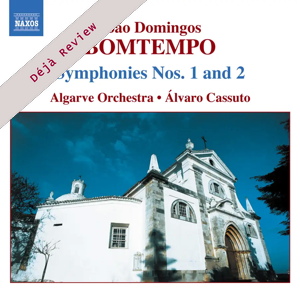
Déjà Review: this review was first published in August 2005 and the recording is still available.
João Domingos Bomtempo (1771-1842)
Symphony No. 1 in E flat major, Op. 11
Symphony No. 2 in D major
Algarve Orchestra/Álvaro Cassuto
rec. 2002, University of the Algarve, Faro, Portugal
Naxos 8.557163 [67]
João Domingos Bomtempo was the most well-known Portuguese composer of the Classical era, but I had not heard a note of his music prior to receiving this disc. After a few listenings, I am very impressed with both the music and program. Symphony No. 1 is firmly in the Classical tradition, mainly of a Haydnesque manner. Symphony No. 2 is a more ambitious and serious work that has early romantic features and contrasts splendidly with the 1st Symphony. Though both are undated, the music leads me to assume that the symphonies are separated by at least a few years. What both works have in common are excellent craftsmanship, fluid phrasing/transitioning and a host of irresistible melody lines. Actually, I consider Bomtempo an exceptional melodist, likely his most attractive compositional trait.
Is Bomtempo a musical genius? Likely not, in that his musical arguments do not constantly advance in a logical and compelling fashion. However, Symphony No. 1 holds up quite well to the Haydn and Mozart models, and the 2nd Symphony is close to being a masterpiece of early romanticism.
Bomtempo certainly had an advantageous musical upbringing. His father was a professional oboist and member of the orchestra of the Royal Court of Lisbon. Bomtempo studied music at Lisbon’s Patriarchal Seminary and was eventually appointed principal oboist of the Royal Court’s orchestra in 1795. He later settled in Paris where he achieved a splendid career as a pianist and composer, an enviable situation that continued when he moved to London. In addition to dozens of works for piano, Bomtempo composed five piano concertos, a Requiem, and six symphonies.
Symphony No. 1, classical to the core, begins with an introductory Largo of heroic proportions assisted excellently by the wind instruments; the ensuing Allegro, in sonata form, is notable for its highly melodic and toe-tapping primary theme. However, even in this exhilarating 1st movement, the development section tends to meander rather than set its sights on promoting the musical arguments of the primary theme. The invigorating Minuetto is very enjoyable with a graceful central Trio section where the winds carry the melody line over a bed of staccato strings. The Andante sostenuto is not as convincing, its series of variations tending to meander around the unremarkable original theme. Fortunately, the symphony concludes well with a high-energy fourth movement Presto that is joyous and delightful throughout.
If Bomtempo’s Symphony No. 2 was similar in style and aesthetics to his first symphony, I would simply recommend the disc to those who enjoy Classical period orchestral music. However, Symphony No. 2 is a significantly different creature having an impact analogous to moving from Beethoven’s first two symphonies to his magnificent and ground-breaking “Eroica” Symphony. First, each movement of Symphony No. 2 is significantly longer than No. 1, the 1st movement Allegro moderato especially generous with a length in the 16 minute range. Second, the fecundity of melodic lines is very fertile and even more appealing than in Symphony No. 1. Third, there is breadth of expression and serious intent not found in the earlier symphony.
Symphony No. 2’s 1st movement is a remarkable creation. The introduction begins in darkness with the low strings but soon enters the world of triumph with a glorious lyricism. The Allegro contains one compelling theme after another, making Bomtempo sound like a ‘melody machine’ in the manner of a Mozart. The 2nd movement Allegretto is also stunning and highly original; the first section has a march-like cadence and blends poignancy with determination, while the central section’s legato and songful phrasing is irresistible. Perhaps most alluring, this central section is not followed by a simple restatement of the first section, but a collaboration of the basic features of both sections. With rousing third and fourth movements, Symphony No. 2 is an important symphonic work of the early romantic period that deserves much greater exposure in the concert hall and on record.
The Algarve Orchestra was founded by Alvaro Cassuto just three years ago to provide Southern Portugal with an orchestra of international quality. Of the more than 800 musicians who applied for positions with the new orchestra, 31 were eventually selected. Definitely a fine orchestra, Cassuto and his forces give idiomatic interpretations of Bomtempo’s music, my sole reservation being a sagging of momentum in the Trio section of the Second Symphony’s Minuetto. The sound quality is a little muddy, but a distinct bloom appears at high volume levels. The main consideration is that the sonics do not detract from one’s listening enjoyment.
In conclusion, I strongly recommend that anyone interested in symphonies from the late 18th to early 19th centuries investigate these two exceptional Bomtempo efforts. Once again, Naxos gives us superb music from an obscure source for a very small price. Now how about those four other Bomtempo symphonies. They need to be unearthed and recorded.
Don Satz
Buying this recording via a link below generates revenue for MWI, which helps the site remain free.




















